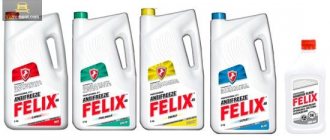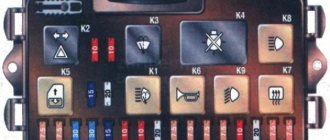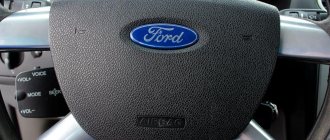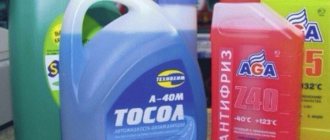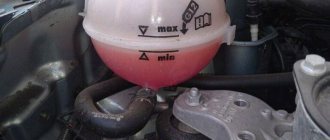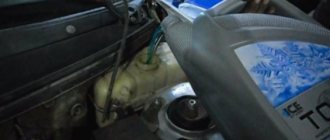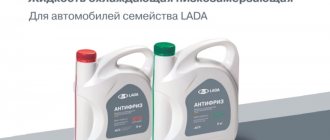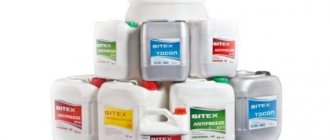Hello, friends. Today there is a lot of debate about what is better antifreeze or antifreeze? Many people believe that there is no difference, this is the name of the same substance. In fact, they are mistaken. These substances are different from each other. Those who do not understand this can harm the engine of their car. Now I will explain why.
Difference between antifreeze and antifreeze
What is the difference between antifreeze and antifreeze, and how can they be distinguished from each other?
- Antifreeze is the international name for coolants for engine cooling systems (required reading: a great educational program on antifreeze).
- Antifreeze is also antifreeze, only domestically produced. It is no worse or better than other coolants.
The word “antifreeze”, in fact, is an abbreviation of the name of the department “Technology of Organic Synthesis” (abbreviated as TOS) of the Research Institute of Organic Chemistry and Technology, where it was developed in 1971. The ending “OL” indicates that it belongs to the group of alcohols.
In those days, no one thought to patent the name “antifreeze” and now it is used by many domestic antifreeze manufacturers. Today, not a single manufacturer produces antifreeze according to the recipe of that very real Soviet “Antifreeze”.
This is neither good nor bad, it’s just that manufacturers use a name popular among car enthusiasts for marketing purposes. Therefore, in most cases, under the Tosol brand, you can purchase high-quality antifreeze for the engine cooling system. The main thing in this matter is to choose a trusted manufacturer, and not to buy the first canister you come across with the inscription “Antifreeze”.
Antifreezes are divided into mineral (class G11), organic (class G12) and lobrid (class G12++ and G13) - the difference between them lies in the base used and additives.
- Antifreeze is a mineral antifreeze. Its service life is 50,000 km or 2 years of operation.
- Organic antifreeze can be used for up to 5 years or 250,000 km.
- And lobrid antifreezes are compatible with any other coolants for cars, and they can be safely added to new engines.
Antifreeze is more used in domestic cars. Antifreeze and antifreeze have the same base - ethylene glycol, but their density is different. Therefore, one hydrometer is used to measure the density of antifreeze, and another is used for antifreeze.
Antifreezes and antifreezes are distinguished according to certain parameters:
- Boiling point;
- Freezing temperature;
- Anti-corrosion properties;
- Lubricating properties.
Coolants are available in colors such as green, blue, yellow and red. This is achieved through the use of dyes.
We have figured out the difference between antifreeze and antifreeze, now we can move on to the next common question among car enthusiasts.
What advantage does antifreeze have over antifreeze?
Experts advise filling the car’s cooling system with a refrigerant that has the greatest number of advantages over analogues.
What is the ability to effectively cool the engine
The main advantage of antifreeze over antifreeze is increased engine cooling efficiency.
Using classic liquids can lead to scale formation. Its thickness on the walls of the cooling system can reach 0.5 mm.
Such a layer can protect the metal from rust, but significantly impairs heat dissipation. Antifreeze in this situation begins to work as an insulator.
The engine is forced to operate at elevated temperatures. This circumstance negatively affects its performance and can lead to breakdown.
The wear rate of parts increases. In this case, the overall engine power decreases.
Carboxylate antifreeze helps prevent overheating. Using liquid does not lead to scale formation. The protective layer appears only in those areas where the effects of corrosion have become noticeable. In this case, the layer thickness does not exceed 0.0006 mm, which does not affect the heat dissipation. By using antifreeze, the car owner minimizes the likelihood of problems with the operation of the engine cooling system.
What is the service life
It is known that silicate packets contain salts of inorganic acids. We can say with great confidence that in the production of Russian antifreezes, nitrites and silicates are mostly used.
Logically, these substances should be classified as antifreezes. Silicates are added to the composition of the consumable material so that during use it reliably protects cooling system parts made of aluminum from corrosion. Nitrites help protect the metal from cavitation erosion. For this reason, they are also included in Russian antifreeze.
The additive packages included in the coolant are balanced. However, this does not prevent them from quickly losing their properties due to a violation of the composition due to the consumption of one of the elements.
Studies have shown that nitrites and silicates are the first to be depleted. If the coolant is made only on the basis of these additives, after 30,000-40,000 km it will completely lose its protective properties.
Unlike domestically produced coolants, foreign antifreezes maintain stability better. This feature is explained by the fact that foreign manufacturers use other additives. Carboxyl technology allows you to achieve coolant stability. The consumption of additives included in antifreeze occurs slowly.
At the same time, the effectiveness of protecting the engine metal from corrosion is not reduced. There is no reduction in engine power. Thus, some brands of foreign antifreeze can properly perform their functions until the mileage reaches 250,000 km.
In other words, foreign-made cooling fluid can not be changed for up to 5 years if it is used for normal operation of a passenger car engine, and up to 7 years if the consumable is used for trucks.
What kind of water pump protection
Many car owners are faced with the fact that the water pump often fails. The main cause of failure is hydrodynamic cavitation.
The course of the physical process leads to the formation of so-called cavities - cavities or voids - in the part.
Their appearance leads to the fact that the blades of the water filter are destroyed and it fails.
Many car enthusiasts are trying to protect their vehicle from hydrodynamic cavitation by trying to choose the right antifreeze that can minimize the destructive effects of the process.
However, a number of experts claim that there is no coolant that can prevent the rapid failure of the water filter at the chemical level.
The statement is only partly true. By choosing carboxylate antifreeze, the vehicle owner will significantly reduce the impact of hydrodynamic cavitation.
This can increase the service life of the water pump by up to 50%.
What is antifreeze
Antifreeze literally translates as “anti-freeze.” This word refers to any coolant from any manufacturer, including TOSOL. The unacceptability of English names in Soviet times did not allow this name to be introduced into Russian automobile slang until the collapse of the Soviet Union. In the early 90s, confusion with this word began, and everyone began to think about the question of how antifreeze differs from antifreeze.
If antifreeze includes a strictly defined set of additives, then antifreeze can be called any coolant with any set of additives. More modern brands of coolants have a service life of up to 200-300 thousand kilometers, in contrast to outdated antifreeze, which must be replaced every 30-40 thousand km.
How the engine is cooled
During operation, the car engine will inevitably become hot. To a certain extent, this is even necessary for its operation. However, overheating is already bad and that is why there is a cooling system. Since airflow alone cannot solve the problem, there is also liquid cooling. This is done either with water or with the help of special liquids - antifreeze.
Both are poured into the radiator. Water is used only in the warm season, because in cold weather it naturally freezes and, expanding (according to the laws of physics), ruptures the radiator and cylinder block. Therefore, with the onset of cold weather, they begin to use antifreeze. However, most drivers do this all year round.
By the way, any coolant is traditionally called antifreeze or antifreeze. Their composition is very similar to each other. It is based on a mixture of ethylene glycol or propylene glycol. Various additives are used as additional components. Each manufacturer has their own set of them.
Thus, the difference between antifreeze and antifreeze lies mainly in the fact that the first is a domestically produced brand of coolant. And the word “antifreeze” literally means “anti-freeze.” The property of not freezing is determined by the presence of ethylene glycol in the composition. But it is a very aggressive substance and causes corrosion in the engine. To counteract this negative phenomenon, various additives are added.
Replacing fluid on a VAZ-2107
Carrying out all the work on this car is not that difficult. Tools you will need:
- Key to 13;
- Key for 30 (possibly);
- Screwdriver;
- Drain container;
You should also take care of purchasing new fluid. In this car, its quantity in the system should be 8.65 liters.
The work is carried out in the following order:
- The car is placed on the platform and time is given to cool down (if the engine is warm);
- Remove the caps from the radiator filler neck and expansion tank. Also in the cabin, on the heater control panel, we move the lever to heating, thereby opening the heater radiator tap;
- Unscrew the drain plug at the bottom of the radiator. On older models there is no such plug, so on them the temperature sensor is unscrewed with a 30 key. There is also a drain plug on the engine, which we also remove. We collect the leaking liquid into a prepared container;
- After draining, install all plugs in place;
- We wash the system. To do this, distilled water or a special detergent is poured into it. In order to completely fill the system and displace the air, remove the pipe going to the intake manifold. As soon as water or liquid comes out of it, we put it in place;
- We start the engine so that it flushes the system through circulation;
- Drain the water through the plugs. Fill in new coolant. We start the motor for circulation. Then we are interested in the amount of liquid in the system and, if necessary, add it to the expansion tank to the required level.
If you choose between Antifreeze and antifreeze, we can say that for optimal and durable operation of the car’s cooling system, it is better to use modern refrigerants, i.e. antifreeze. In summer, they cool the engine well, are less aggressive to the pipes, and have a large number of additives that will help protect the unit from corrosion. In addition, they need to be changed less often. If we draw a line on what is better to use, then the green G11 antifreeze is identical to Antifreeze, the red G12 coolant is a little better, and G13 is a technological revolution, the only question remains is the price. Antifreeze is several times more expensive than Antifreeze, but when making a choice, you should not save on car coolants, because repairs will be more expensive.
Features of the transition from antifreeze to antifreeze
When switching to a new type of liquid, it is necessary to drain the existing solution and rinse the circuit with distilled water. To remove deposits, you can use a special preparation (for example, Hi-Gear cleaner). Some owners repeat the procedure 2-3 times or connect a hose with tap water to the circuit (followed by rinsing with distilled water). After cleaning is completed, close the drain valves and fill the jacket and radiator with new liquid (controlling the level according to the mark on the body of the compensation tank).
Difference between antifreeze and antifreeze
Previously, when cars were equipped with cast-iron impenetrable engines, a fluid based on ethylene glycol and water did not cause any harm. Now (in modern cars), hot antifreeze, flowing through the system, threatens cylinder blocks and radiators. To protect the system, Antifreeze was created and it was then that this coolant became associated with domestic cars.
In fact, there is no difference between Antifreeze and antifreeze. Antifreeze is the same antifreeze, only produced by us. It can be sold in the market in both blue and red colors.
The difference lies in the following parameters:
- boiling and freezing temperatures of coolant;
- properties protecting against corrosion;
- lubrication parameters.
What categories of coolant can be mixed
Of course, the best option would be to fill the system only with liquids from one category, but if for some reason this is not possible, then you should use the following compatibility table:
- Antifreeze Tl - only with antifreeze Tl.
- G11 can be mixed with G13, G12+ and G12++.
- G11 must not be added to G12.
- G12 can be mixed with G12+, G++, G13.
- G13 cannot be mixed with G12, but with other types it can.
Being guided solely by the color of the coolant when purchasing/refilling/replacing it is fundamentally wrong. Some manufacturers paint antifreeze and antifreeze in colors different from the generally accepted ones. The color has no effect on the chemical composition and density of the liquid.
[custom_ads_shortcode1]
Is it possible to mix antifreeze and antifreeze and what happens if you mix?
Both liquids - antifreeze and antifreeze are manufactured using different technologies, and they cannot be mixed . If the car was operated with antifreeze, and its owner decided to switch to antifreeze, before refilling, the cooling system is completely cleared of traces of old coolant.
When mixing antifreeze and antifreeze, a chemical reaction occurs between the additives, as a result of which some compounds coagulate and precipitate, which can clog the channels and ducts of the cooling system. This will lead to engine overheating and subsequent expensive repairs due to excessive oil consumption due to stuck piston rings.
We recommend: Is it possible to flush the engine with diesel fuel?
Antifreezes have different compositions and are divided into mineral (class G11), organic (G12), and lobrid (G12++, G13). The difference between them lies in the additives:
- Antifreeze is classified as mineral antifreeze, which has a service life of 50 thousand km or 2 years of use.
- Organic ones can be used for up to 5 years or 250 thousand kilometers.
- Lobrid fluids can be combined with any other cooling fluids and added to new engines without fear.
To summarize, we can say that choosing the right coolant for your car in our time is not a problem, be it antifreeze or an expensive lobride. The problem is different: there are too many of them, and it’s easy to get confused in the variety. The main thing is to take into account all the manufacturer’s recommendations and not chase what is cheapest, but choose a high-quality composition that will definitely not harm the car. Moreover, you will have to spend money once and for a long time.
How can I find out what kind of coolant was filled in at the factory?
In the vast majority of cases, it is very easy to find out the brand of antifreeze that was initially poured - just look at the sticker placed on the tank. This sticker always indicates in large letters the liquid with which the system was filled (and which it is recommended to add as needed).
In the vast majority of VAZ 2114 cars, the liquid filled at the factory is either Felix TC-40, produced in Dzerzhinsk, or CoolStream Standart 40, produced in Klimovsk. They can also be distinguished by color. The first is bright green, the second is either green-yellow or faint green, in both cases there is slight fluorescence. Both of these liquids are antifreeze (belonging to class G11), and they can only be mixed with other liquids from this class.
Many people believe that Antifreeze is much worse in quality than antifreeze, so they cannot be mixed. This is incorrect - the reason lies not in the quality or acidity of the medium, but in the very different densities of these two liquids. If it is not intended to replace the coolant with a liquid of a different category (for example, antifreeze for antifreeze), then you can add it without draining the entire cooling system. Otherwise, this operation will be strictly necessary.
[custom_ads_shortcode2]
The history of the evolution of antifreeze and antifreeze for the cooling system
As we mentioned, we'll start with water. The main drawback of water, which became apparent very quickly, apparently in the first winter, was its crystallization, the usual freezing at sub-zero temperatures. There is nothing good if the engine not only does not “crank”, but does not “crank” at all. To solve this problem, coolant crystallization, alternatives have been proposed. Actually, it was necessary to splash something into the water so that it would not freeze. Now let’s take a look at those liquids that have been used with varying degrees of success and could become an alternative to today’s antifreeze and antifreeze.
— Glycerin
Glycerin is a colorless, viscous, hygroscopic liquid, infinitely soluble in water. It tastes sweet, which is why it got its name (glycos - sweet). By the way, glycerin is still used in some antifreezes. However, a couple of significant disadvantages of glycyrin later became clear. This is still a relatively high freezing point (-18ºC). Well, the main disadvantage is its significant viscosity; to put it even more simply, it itself is like jelly. This consistency of the coolant in the system affects the useful power of the engine, due to the need to pump it all through the cooling system. That is, glycerin as a whole will reduce the efficiency of the engine, on which the car’s dynamics, consumption and, most importantly, our mood depend!
— Methanol
Methanol is a colorless liquid with an odor reminiscent of ethyl (drinking) alcohol. With the use of methanol, the freezing temperatures of the coolant have become significantly lower. So much lower that you don’t need that much. The freezing point is 97º C. It also has the right viscosity. Everything seems fine, but it actively reacts with aluminum. Especially if you warm it up, which is what happens in the engine. In addition, like alcohol, it is also a fire hazard. Such an unfavorable neighborhood could not only lead to rapid wear of the engine due to corrosion, but it could also burn out even earlier. In addition, methanol is a poison that affects the human nervous and vascular system. The toxic effect of methanol is due to the so-called “lethal synthesis” - metabolic oxidation in the body to toxic formaldehyde. In addition, methanol has cumulative properties, that is, it tends to accumulate in the body. Ingestion of 5-10 ml of methanol leads to severe poisoning (one of the consequences is blindness), and 30 ml or more leads to death. The maximum permissible concentration of methanol in the air is 5 mg/m³ (half that of ethanol and isopropyl alcohol). Currently, methanol is prohibited for use in antifreeze, antifreeze, and glass cleaners.
— Ethanol
Ethyl alcohol is exactly that alcohol C2H5OH, which is part of numerous alcoholic beverages consumed by humans. Alcohol could be widely used for antifreeze and antifreeze. The advantages of ethyl alcohol are obvious: it is relatively harmless to humans, has a low freezing point (-117ºC), and has low viscosity. Of course, everyone knows the main harmful property of ethanol - alcoholism, but this article is not about that. Also, a little off-topic, but it's worth adding that ethanol is an antidote for poisoning with some toxic alcohols, such as methanol (see above) and ethylene glycol (we'll cover it later), this does not mean that it reacts with them, just when it gets into the body undergoes competitive oxidation of living tissues with it and subsequently the impossibility of oxidation with other toxic alcohols in the body. Why didn't it take root? Yes, because again it is a fire hazard, reacts with aluminum, and even the fight against alcoholism in the USSR was carried out on a very large scale. Although alcohols were issued as a liquid for filling into the brake systems of trucks. What happened, happened!
— Ethylene glycol
This is also essentially a dihydric alcohol. And it was precisely this alcohol that was destined for the fate of being widely used in antifreeze and antifreeze. This alcohol is poisonous and you definitely shouldn’t drink it! Lethal dose 35 cc orally. So, ethylene glycol is now the main basis for coolant in most cases. It would be simply blasphemous not to talk about it in more detail, because it has amazing properties!
Its amazingness lies in the fact that 100% ethylene glycol freezes at a temperature of only about -13ºС, but when water is added to it, the freezing point begins to drop!
Interesting, isn't it!? Moreover, the lowest freezing temperature of a solution of ethylene glycol and water will be at a ratio of 65%! ethylene glycol and 35%! water accordingly. In this case, the freezing temperature of the coolant will be about -70 degrees Celsius. A regular solution of 60% ethylene glycol and 40% water freezes at -45°C and is actually a solution of antifreeze or antifreeze. That is, if you can’t save on ethyl alcohol, since there is a direct dependence on how you dilute it with water and the freezing temperature will increase, then the opposite is true. That is why, apparently, ethylene glycol has taken root as the basis of antifreeze. So, mixing water and ethylene glycol actually produces antifreeze or antifreeze, but additives are also important, which make the antifreeze truly high-quality!
— Propylene glycol
Here is a new page in antifreeze. Whether it will become the main component instead of ethylene glycol is a big question. The main problems are that it is more expensive and more viscous, especially at low temperatures. However, it is environmentally friendly, which is very fashionable in developed countries, this is its main strong point! It is even used in the food industry for cooling systems. In general, this is the best for warm and developed countries, but obviously not for Russia, where it is cold and no one will overpay for the environment and their own health.
Types of antifreeze
Antifreeze is a refrigerant developed by domestic manufacturers. The liquid is primarily used to ensure the functioning of the cooling system of Russian-made cars.
Today there is a whole range of varieties of antifreeze, differing in freezing temperature and other properties.
TOSOL A-40M
Antifreeze A-40M - developed by domestic manufacturers. Its main component is glycol alcohol.
To give the substance the properties of coolants, manufacturers add up to 10 different additives to it. They prevent foam formation and corrosion.
Antifreeze A-40M is odorless and has a sweetish taste. To make the liquid different from others, it is painted in unnatural colors.
Antifreeze made by Russian manufacturers usually has a blue or light green tint. When using the substance, you must remember that it is very toxic.
Experts advise avoiding getting coolant on your skin. If antifreeze accidentally gets on the car enthusiast’s body, it is necessary to wash off the liquid with plenty of water.
When choosing between different types of coolants, you need to carefully study their properties.
Thus, antifreeze A-40M has the following characteristics:
- has a boiling point of +108 degrees,
- has low viscosity,
- does not have a negative effect on the parts of the cooling system,
- does not freeze at temperatures down to -40 degrees,
- does not foam
- remains chemically stable during operation and storage,
- has high thermal conductivity.
Antifreeze A-40M differs from antifreeze by a set of additives that prevent corrosion. Mixing coolants is prohibited.
The components included in their composition may react, and the properties of the coolant will change.
Antifreeze A-40M is designed for a range of 60,000 km. When the mark is reached, the fluid must be replaced.
If the car owner does not use the vehicle very actively, the antifreeze needs to be changed at least once every 2 years.
Experts advise me to use the liquid used for the same brand. If a car owner plans to change Antifreeze A-40M to another antifreeze, the cooling system must be flushed.
The use of this brand of coolant is associated with a number of positive and negative aspects. Thus, antifreeze A-40M contains additives that protect cast iron, copper, steel, and brass.
However, there are no substances to protect aluminum. This makes the coolant ideal for use in the cooling systems of domestic VAZs, but prevents its use in foreign cars.
In addition, the liquid has a relatively high freezing point. In regions with harsh winters, the use of antifreeze A-40M is not possible.
TOSOL A-65M
Antifreeze A-65M is another type of coolant that is popular among Russian car owners. Coolant is used to cool different types of engines:
- passenger cars,
- freight transport,
- domestically produced cars,
- vehicles manufactured abroad.
The liquid differs from other consumables for the car cooling system in its resistance to sudden temperature changes.
The additives included in antifreeze function perfectly both at +110 and at -65 degrees Celsius. The liquid meets the requirements of the state standard.
It does not have a negative effect on cooling system parts made of rubber and plastic.
The basis of antifreeze A-65M is ethylene glycol. Coolant can be mixed with products of other brands based on the same substance. However, experts advise resorting to action only in extreme cases.
Antifreeze A-65M has the following characteristics:
- crystallization occurs if the temperature drops below – 65 degrees,
- coolant density is 1.085 - 1.100 g/cm3,
- the refrigerant may boil if the temperature rises above +110 degrees,
- foam disappears in no more than 3 s,
- has a hydrogen index of 7.5 - 11.0.
The positive features of this brand of coolant include good thermal qualities. In addition, antifreeze has good lubricating properties. However, the substance is aggressive.
A number of car enthusiasts claim that its use can damage parts of the cooling system.
TOSOL AM (concentrate)
Unlike other coolants, Antifreeze AM-K is not used immediately after purchase. Before pouring liquid into the car’s cooling system, it is first diluted with distilled water.
The main component of Antifreeze AM-K is ethylene glycol. In addition to the main component, the coolant includes:
- water,
- additives that prevent corrosion,
- coloring matter,
- additives that prevent the formation of foam.
Externally, AM-K antifreeze does not differ significantly from other products that ensure the normal functioning of the car’s cooling system.
It is a blue liquid without mechanical impurities. However, AM-K antifreeze has one of the highest freezing temperatures among analogues. Its crystallization occurs already at -35 degrees Celsius. This feature is the main disadvantage of the product. The advantages include its low cost.
| Index | Features of antifreeze AM-K |
| Alkalinity | 10 cm3 |
| Rubber swelling | No more than 5% |
| Refrigerant crystallization temperature | -35 degrees Celsius |
| Product Density | 1.120-1.150 g/cm3 |
| Foaming | No more than 30 cm3 |
| Foam disappearance time | No more than 3 s |
Antifreeze characteristics
Before deciding what is better to use - antifreeze or antifreeze - you need to understand the general characteristics of the products. Antifreeze is a coolant. It does not freeze at low temperatures. It includes:
ATTENTION! A completely simple way to reduce fuel consumption has been found! Don't believe me? An auto mechanic with 15 years of experience also didn’t believe it until he tried it. And now he saves 35,000 rubles a year on gasoline! Read more"
- ethylene glycol;
- water;
- inhibitors.
This combination gives the product anti-corrosion properties. It is available in two forms: ready-mix and concentrate. The latter needs to be bred independently. The liquid is also distinguished by color. Red antifreeze is considered the best option. It consists of an organic base that effectively performs its tasks. A small addition of carboxylic acid prevents the formation of films. The liquid removes small areas of corrosion.
The green mixture is a combination of organics and chemicals. It is less efficient, reduces heat dissipation and contributes to the appearance of plaque, although its cost is much cheaper.
According to GOST, coolant, be it antifreeze or antifreeze, should not contain mechanical impurities. It should be transparent and uniform. Antifreezes of different classes may have the same color, but this does not mean that they can be mixed with each other. Even when mixing antifreeze from different manufacturers, a suspension of small but solid particles may appear.
We recommend: Inoperative window regulators: causes and solutions to the problem
And when mixing mineral and synthetic antifreeze, even if they are of the same color, a cloudy sediment is almost guaranteed to form, which will certainly settle in the car’s cooling system. This sediment will eventually clog the radiator, stop the pump and cause the engine to boil.
If you mix antifreezes of the same category, but of different colors and manufacturers, then most likely their characteristics (for example, freezing and boiling points) will not change. However, after heating, a suspension of barely noticeable solid particles may form in such a mixture. It is impossible to say unambiguously or somehow predict how this “suspension” will behave in the engine cooling system.
To avoid problems with your car, we do not recommend engaging in such dubious experiments on mixing antifreeze, and we recommend periodically flushing the engine cooling system.
Experience shows that, relatively safely and without dire consequences for the engine, mineral (G11 or antifreeze) and organic (G12) antifreezes can only be mixed with high-quality universal antifreeze of the G12++ class. Therefore, if you don’t know exactly what kind of coolant is in your car, then you shouldn’t risk it again - only top up with universal antifreeze.
How to determine what is flooded?
Of course, the most accurate answer to the question about the contents of the radiator will only be given by a special chemical examination. But with your own efforts you can at least determine whether it is filled with antifreeze or antifreeze. But first of all, it is worth remembering that you should not focus on color. Antifreezes also come in blue, as already mentioned. It is highly not recommended to taste liquids. Firstly, taste is not an indicator, and secondly, refrigerants are extremely toxic. The main methods available to everyone:
- by smell and touch. Antifreeze does not smell of anything, but feels oily to the touch, which cannot be said about antifreeze;
- using water. To do this, a small amount of liquid is poured into a jar, after which a little water is added there. As a rule, various effects appear in antifreeze: cloudiness, delamination, and others. This is not observed in antifreezes;
- using a hydrometer. The density of antifreeze and antifreeze is different. Antifreezes give readings of 1.072 g/cm3 to 1.080 g/cm3. Measurements should be taken at room temperature.
So, as can be seen from the above, the composition of antifreeze and antifreeze has differences that affect its qualities and characteristics. Although their base is almost the same. Therefore, both are coolants. Under no circumstances should they be mixed with each other, as this can lead to various consequences, both for the cooling system and for the engine itself.
What is TOSOL
The abbreviation TOSOL was created back when the first VAZ cars rolled off the assembly line. In the literal sense, the word TOSOL meant “Technology of Organic Synthesis of a Separate Laboratory.” Subsequently, this abbreviation began to be called the only coolant produced in the USSR. For 20 years, antifreeze had no analogues, so the only brand of coolant became so ingrained in the minds of car enthusiasts that its name is still used to designate any coolant.
Ethylene glycol, water and a number of additives were added to the antifreeze composition, among which nitrites, nitrates, silicates and phosphates can be distinguished. The additives did their job well, although they had side effects such as low heat transfer due to the formation of a thick protective layer on the internal surfaces of the engine cooling system channels.
How to spot a fake
To test purchased material at home, you must:
- Pour a portion of the liquid into a metal container and place it on an electric stove, while simultaneously monitoring the temperature with a thermometer or using a thermocouple connected to a multimeter. High-quality material will boil when heated to +105°C (the higher the parameter, the better the solution). If you have a refrigeration unit, you can place the liquid in the freezer compartment and reduce the temperature as much as possible.
- Bring the solution to a boil and carefully bring an open flame to the surface. Periodic flashes or stable burning of vapors indicate the presence of traces of organic alcohols in antifreeze, which is unacceptable by standards.
Antifreeze or antifreeze for VAZ-2109 and other models
Now let's look at this situation on more modern cars. So, what is better - Antifreeze or antifreeze for the VAZ 2109. Similar questions can also be included here: VAZ-2114 - Antifreeze or antifreeze, VAZ 2115 - Antifreeze or antifreeze.
The situation with these cars is similar to the VAZ-2107 model. That is, antifreeze is standard for these cars, but it is also possible to use antifreeze, but only of certain brands.
Replacing fluid on a VAZ-2110
As for the replacement procedure, let's look at how to replace Antifreeze with VAZ-2110 antifreeze or vice versa:
- The car is installed on the platform and cooled;
- The expansion tank cap is removed, the heater tap is opened, the plugs on the radiator and crankcase are unscrewed, and the waste fluid is drained into a container;
- The plugs are installed in place and flushing liquid or distillate is poured into the system. The engine starts to circulate the fluid;
- The flushing fluid is drained, and then fresh antifreeze or antifreeze is added;
On other specified models, the operation is performed similarly.
And as a result, we note that antifreeze is still better than Antifreeze in its properties, but it also costs more. If you want to take better care of your car, then you should fill it with antifreeze, but only of the appropriate brand. But a feature of our automobile industry is the possibility of system leakage, and replenishing the level of antifreeze can be expensive.
Antifreeze also does a good job, but it needs to be changed more often, but it costs less.
Antifreeze or antifreeze - which is better to use?
You need to choose what is better to use (antifreeze or antifreeze) based on the characteristics of the machine’s cooling system.
Since for different cars it consists of different materials, some brands use predominantly more copper and brass in the cooling system, while others use aluminum and its alloys.
Thus:
- Red antifreeze is suitable if your car radiator consists largely of copper and brass (yellow radiator).
- Green antifreeze is suitable when there is more aluminum and its alloys in the heat exchanger (silver radiator).
- antifreeze is suitable if you have a domestic car (especially for old cast iron engines).
For each machine there are recommendations from the manufacturer. Therefore, the most correct thing would be to fill the system with antifreeze or antifreeze, the brand of which is indicated in the vehicle’s operation and maintenance manual.
Composition and properties of antifreeze and antifreeze
The basis of Antifreeze is ethylene glycol. This refrigerant has excellent stability at low temperatures. Since the times of the Soviet Union, to differentiate the boundaries of freezing, Tosol has been painted blue and red. The difference between these two types is only in the dye, alcohol concentration and crystallization temperature. Blue refrigerant freezes at -40°C, red refrigerant freezes at -65°C. Antifreeze is used in internal combustion engines.
As a rule, the general composition of blue and red liquid is as follows:
- ethylene glycol;
- glycerol;
- distilled water;
- silicate additives.
But, as is known, ethylene glycol paired with distilled water has a destructive corrosive effect on the cooling system. In this situation, it is the additives that protect the pipes. They cover the inner surface of the hose with a thin layer of film and thereby eliminate direct exposure to aggressive components.
Antifreeze, in turn, is a group of refrigerants that remain liquid at low temperatures. They are used not only in internal combustion engines, but also in aviation fuel.
In general, the composition of antifreeze is similar to Antifreeze:
- ethylene glycol;
- glycerol;
- distilled water;
- additives.
But in some models, antifreeze differs quite significantly in additives. The more expensive the liquid, the better the additive and the longer its use. In addition, the G13 standard refrigerant includes a propylene glycol base.
The main difference between these two refrigerants is the chemical or organic additives. The basic composition is almost identical.
Modifications of red antifreeze
To solve problems with corrosion formations in the system, antifreezes were developed, called G12+, G12++. Which differ from G12 by the addition of chemical additives in an amount of 10-15% of their total volume.
Thanks to the preventive functions of inorganic compounds, it was possible to achieve less formation of corrosion centers without a significant loss of heat transfer.
Yellow antifreeze (G13) . Developed by VAG in 2012 specifically for its cars. The original color used on German cars is purple.
The base contains propylene glycol and distilled water. Compared to ethylene glycol, this compound is practically harmless. The addition of hybrid additives (organic and chemical) to its composition increases its preventive and protective functions. Freezing temperatures are about -40 degrees. Boils at +140 degrees.
Coolant separation
The basis of coolants is a mixture of ethylene glycol, water and additives that protect the metal from corrosion. Refrigerant manufacturers have their own unique composition, which differs in additive production technology. Additives are a mandatory component of coolant.
When choosing antifreeze or other antifreeze for your car, you need to pay attention to the instructions for use and read the manufacturer’s recommendations. The manual contains a list of tests and experiments with liquid, names of coolants and their class affiliation.
Production technology comes down to:
- classical, when the composition is based on additives from salts of inorganic acids;
- carboxylate: the basis of this technology is corrosion protection based on organic acids, that is, carbonates;
- hybrid production technology is a branch of the second method, where additives are formed using salts of carboxylic acids with an admixture of silicates and phosphates.
We watch a video from Alexander Skripchenko about the thoughts of experienced motorists on this topic.
Antifreeze
Antifreeze will protect your car from overheating. Its boiling point reaches one hundred and fifty degrees Celsius. In frost it stays up to thirty-eight degrees. Among other things, key elements of antifreeze, such as various additives, help protect machine parts from metal corrosion.
If antifreeze did not have additives, its rather aggressive components would work to destroy the walls of the radiator. Water mixed with ethylene glycol without additives will eat pipes, rubber tubes and even the engine in a matter of months. Active experiments are currently underway to improve additives. To show their differences in the automotive market, coolants began to be produced in different colors: blue, red and green.
- G11, G11+, G11++. This antifreeze is green in color. Withstands temperatures from -40 to 130 degrees, this is a distinctive advantage compared to Antifreeze. The second plus: when a “malignant formation” forms, that is, corrosion, carboxylic acid, which is part of the additives, begins to work.
- G12, G12+, G12++. This is red antifreeze. It is more advanced and is perfect for delicate cooling systems of foreign cars. There are no chemical additives in its composition, but there are organic ones. This is a definite plus. This improves heat transfer.
Gallery “What to choose and use for the engine?”
Photo 1. The best antifreeze for aluminum radiators - green
Photo 2. Blue antifreeze
Photo 3. Red antifreeze for copper
Antifreeze
This is a traditional technology for preparing coolant. Under the word “Antifreeze”, both high-quality antifreezes of international production and counterfeits can be sold on the market. However, there is not a single modern company that would prepare the liquid according to the recipe according to which it was made in Soviet times. In a market where every second canister and can is called “Antifreeze”, it is better to give preference to a trusted manufacturer.
Blue antifreeze - Antifreeze
We recommend: The engine overheated on the highway, what should I do?
Which cars are more suitable for antifreeze, and which ones are antifreeze?
Since antifreeze is an antifreeze based on salts of organic acids, there is no strict connection between the type of car engine and the type of coolant. For example, from the factory, the engines of VAZ-2110 cars (both with an 8-valve gas distribution system and with a 16-valve head) are filled with coolant-40 standard material. The owner can independently fill the solution with standard G-11 (there is no difference in physical and chemical characteristics between the materials).
Benefits of using antifreeze
Most motorists prefer antifreeze when choosing a coolant, based on the following reasons:
- Increased cooling efficiency due to a more advanced additive composition. Antifreeze creates a protective layer only in those areas that have been corroded.
- Possibility of long-term operation while maintaining all basic properties.
- Good protection of aluminum parts of the cooling system at high temperatures.
- The water pump operates in a gentle mode , which is achieved by using carboxylates, which protect it from water hammer during cavitation.
- Chemical inertness , due to which new compounds are not formed in the cooling system and metal, rubber and plastic surfaces are not damaged.
Where liquids are used and terms of use
Solutions are used in cooling systems of internal combustion engines installed on tracked or wheeled vehicles, as well as on aircraft.
Recommendations for the type and composition of the liquid are indicated by the manufacturer in the technical documentation.
The service life depends on the degree of heating of the material; under standard conditions of use, replacement is made after 2-3 years for silicate compositions and after 5 years for carbon or lobride compositions. Information about the frequency of maintenance is indicated on the label or in the instructions for the car.
What is antifreeze
Antifreeze G12+ and G11
Antifreeze, as already mentioned, comes from the English word “anti-freeze”. That is, it is a liquid that does not freeze in cold weather. Let's try to figure out what liquids are common today under this name.
Antifreeze is a coolant for modern internal combustion engines, which contains an alcohol (glycerin) base and additives. Actually, the additives, which differ from those used in antifreeze and from each other, are the whole point.
What types of antifreeze are there?
All antifreezes existing today, depending on the composition and production technology, can be divided into two large groups - silicate, produced using traditional technology, and carboxylate, produced using organic acid technology. There are also options where both are involved, and it’s easy to get confused with all these differences.
There is no international classification of antifreeze. Therefore, many manufacturers secretly adopted as a standard the system of standards that was originally invented and used by the Volkswagen concern for its own coolants. Borrowing it allows you to sort all types into shelves.
Today the following antifreeze standards are used:
- G11. Traditional or silicate antifreeze. It contains ethylene glycol, silicates and other inorganic substances: phosphates, borates, nitrites, nitrates, amines. In this respect, antifreeze is similar to antifreeze - as was written above, it also contains various compounds. Such coolants cover the parts of the cooling system from the inside with an even layer, which provides them with lubrication and protects them from wear and corrosion. However, this same layer significantly worsens heat transfer, and precipitates due to vibration and temperature changes. Therefore, it is better to change such fluid at least once every two years.
- G12. Refrigerants of this standard are the next generation. They are based on the technology of organic (carboxylic) acids. That's why they are called carboxylate. They do not contain silicates, as well as their entire company in the form of borates, amines, nitrates and other compounds. Such liquids do not create any layer on the surface of the parts, resulting in excellent heat transfer. But against corrosion, they act in a targeted manner - that is, directing inhibitors to where this corrosion has already begun. Unfortunately, carboxylate antifreezes cannot prevent it from starting.
- G12+. The so-called hybrid antifreeze. When creating it, manufacturers decided to combine all the best that exists in traditional and carboxylate technologies and mixed organic additives with inorganic ones. As a result, such a composition simultaneously creates a protective layer and destroys already existing foci of corrosion.
- G12++. An even more advanced carboxylate refrigerant. It contains mineral additives added to the organic base.
- G13. This is the newest generation of coolant. Lobride antifreeze is produced not on the basis of ethylene glycol (and its variations), but on propylene glycol. Unlike its predecessor, it is not poisonous and is considered environmentally friendly. And such refrigerants have an almost unlimited service life.
Each of these standards has its own advantages and disadvantages, so each has its own connoisseur.
Antifreeze color
Antifreeze in different colors
Antifreeze can be found in almost any color. There is a common myth that the same colors mean the same properties, which means that green can be safely added to green, and red to red. This is a misconception.
In fact, all coolants (including antifreeze!) are themselves transparent and colorless. They began to add dye to them because they are poisonous, so as not to be confused with water. By the way, for the same reason, a bitter flavoring additive is added to many foreign-made refrigerants so that, for example, a child cannot drink too much out of curiosity and end up poisoned. The second reason for adding dye is to quickly find and repair leaks. Many manufacturers also add a fluorescent component for this purpose.
Important! The dye does not in any way affect the composition and properties of the product, and there are no standards regulating the choice of shade. Therefore, the choice remains with the manufacturer. This is why you should not mix antifreeze by color.
However, although there are no standards in this regard, most manufacturers try to adhere to the following rules:
- Coolant G11 – blue, light blue, green, blue-green, turquoise;
- Coolant G12 (with and without pluses) – all shades of red, orange;
- Coolant G13 – pink, purple.
It's approximately. In fact, there are carboxylate liquids that are green and lobrid liquids that are yellow. Some manufacturers have entire lines in which the same antifreeze composition is painted, for example, in four different colors.
Temperature Range
The temperature range of modern coolants is also different. The boiling point is approximately at the same level – +110-115 degrees Celsius. But the freezing temperature varies. Most ready-to-use coolants operate to a limit of minus 36-40 degrees Celsius. There are options for the northern regions - minus 50 and 65.
In addition, there are coolant concentrates. They cannot be used in pure form; they must be diluted with distilled or demineralized water. The temperature at which crystallization begins depends precisely on the percentage of water and base.
Scope and terms of use
There is a wide variety of antifreeze on the modern market. Therefore, you can choose your own option for a car of any brand, domestic and foreign, old and new, with different types of engines and the fuel on which it runs.
The shelf life of antifreeze also varies depending on its composition and production technology. For most traditional ones it is 2-3 years, for carboxylate ones - 5 years, for lobrid ones - from 5 years and above. However, this is all approximate. In addition to the replacement interval for the coolant itself, you also need to take into account the recommendations of the car manufacturer.
Naturally, the global community is constantly evolving and the latest trends that ensure environmental friendliness and extend the service life of cooling system elements are the use of propylene glycol. Antifreezes and antifreezes based on propylene glycol are more environmentally friendly, it is not toxic to humans, propylene glycol is used in the production of food (additive E1520), medicines and perfumes, as well as in residential heating systems. Used in electronic cigarettes.
Today, most municipal transport in Europe has already switched to propylene glycol. Propylene glycol, unlike ethylene glycol, is slightly less aggressive towards metals and has better thermal conductivity. In general, this liquid is the future, used for cooling systems in cars and as coolants for heating systems in residential and industrial buildings. However, propylene glycol is more expensive than ethylene glycol, is slightly more viscous, and at the same ratio with water has a higher freezing point... This can become a stumbling block.
Antifreeze classes
Antifreezes are classified using the letter G and a number, by which one can judge its composition and properties. The forefather of this marking is the world-famous Volkswagen company, which at one time produced the popular brands of antifreeze “VW coolant G 11” and “VW coolant G 12”.
Thus, in accordance with the labeling adopted by Volkswagen, the following types of antifreeze are currently used:
Inhibitor content depending on mileage
- Silicate, designated as G11 (meets VW specification TL 774-C). By the way, the old Soviet “Tosol” also belongs to this type. The operating principle of the composition is to form a thin protective film that prevents corrosion of the cooling system elements. Volkswagen recommended it for cars of its own production until 1996. Typically, G11 fluids are green or blue in color. The liquids contain nitrates, amines, nitrites, borates, phosphates, and silicates.
- Carboxylate, designated G12 (meets VW specification TL 774-D). In Europe, G12 antifreezes are recommended for use in cars produced before 2001. Has a red or pink color.
- Hybrid, G12+ (complies with VW TL 774-F specification). Designed for high-speed engines with high temperature loads, used for cars manufactured in 1997...2008 (in our country they are also used for newer ones). Has a red color.
- “Lobrid” (Lobrid) . Has index G12++ (corresponds to VW TL 774-G specification) or G13 . In the latter case, instead of ethylene glycol, propylene glycol is used as a base. Such antifreezes are non-toxic, quickly decompose and cause significantly less harm to the environment. However, their disadvantage is their high cost, so they are rarely used in the CIS countries. These antifreezes are recommended for use in cars manufactured in 2008 and later. It has an orange or yellow color.
It is worth noting separately that the majority of antifreezes sold on the domestic market do not meet the mentioned specifications from Volkswagen. In addition, in order to have an official license, antifreeze must be certified in the company's laboratories. Naturally, 99% of liquids sold have not passed such a test. Therefore, the classification of antifreeze according to the G-parameter is very conditional, and should be treated with a grain of salt.
G12 antifreeze, its features and differences from other classes of antifreeze
Antifreeze G12 is designed for the coolant system of a modern engine. It has its own characteristics and differences from antifreeze G11, G12+, G13. The difference in the compatibility of g12 antifreeze with other coolants is in stabilizing additives Read more
Replacing antifreeze VAZ 2110
When replacing, it is important to remember that the liquid is toxic and should only be changed on a cold engine. You should start the procedure by unscrewing the cap of the expansion tank. More details
Flushing the engine cooling system. 5 main mistakes
What are the most common and dangerous mistakes when flushing the cooling system? You can get into trouble when choosing a flushing agent and with the coolant itself... Read more
Let's compare the properties
To make the advantages, disadvantages and possible compatibility clearer, I will compare liquids by type.
Antifreeze and G11
The color of antifreeze of this classification is green. Comparing the properties of antifreeze with antifreeze of this marking, we are convinced that the domestic liquid corresponds to the imported G11 marking.
The operating principle of their additives is similar - the formation of a film that prevents corrosion of the cooling jacket, radiator, and protects rubber hoses. The disadvantages are the same - the film reduces heat transfer, in the summer the engine gets hotter than with other coolants.
This means that it is permissible to pour one substance instead of another, but they cannot be mixed with each other.
Mixing is a common mistake among amateurs. This causes foaming of the coolant, loss of properties, and sedimentation, which can lead to boiling and overheating of the engine.
Both substances are replaced every two years, this is caused by sedimentation and loss of properties.
Antifreeze and G12
The color of antifreeze of this classification is red, like antifreeze 65. G12 contains ethylene glycol and water, and this is where their similarities end. The additives of this type of antifreeze are organic. Among them, carboxylic acid.
The absence of a protective film improves engine cooling, which is so necessary for high-temperature modern engines. Any rust is instantly dissolved by acid. Serves up to 4 years.
Important: The previous version had chemical additives. These types of additives are incompatible with each other. Mixing G12 with antifreeze or G11 is unacceptable.
This classification of antifreeze is superior to antifreeze in terms of service life and cools better. They can be used in VAZ cars.
Antifreeze and G13
Antifreeze of this type is the pinnacle of the evolution of coolants. The composition is as follows:
- Propylene glycol is considered a non-toxic substance that is safe for human health. (Appears only in formulations marked G13 and higher).
- Distillate
- High quality hybrid additives
If version 11 protects against corrosion, but reduces heat transfer. And 12 does not protect against corrosion, but here the effect is combined. From compatible additives. Mixing with previous versions of antifreeze or with antifreeze is not allowed. Differences between additives will cause foaming, sediment and loss of properties.
These antifreezes are better than previous generations, and are definitely superior to antifreeze in quality.
Let's sum it up
When you have the opportunity to choose, even for the VAZ 2110, it is preferable to buy antifreeze instead of antifreeze. Of course, class from G12 and above. The cost of 5 liters of antifreeze will cost 300-650 rubles. The same canister of antifreeze will cost 1,400–2,000 rubles. Class G13 will cost 3000 rubles.
Here everyone will think about expediency and savings. However, it is in this matter that saving is not recommended. This is an option where you save a thousand and lose five. For modern Nissan Priora engines, a minimum coolant class of G12 is required. It is more efficient in cooling, which reduces engine wear. And on antifreeze, with such an engine you can boil.
Antifreeze can withstand high temperatures, while antifreeze decomposes and loses its properties already at 105 degrees. Sediment clogs the sensors, and one malfunctioning injection engine sensor causes a malfunction of the entire engine control system.
Antifreeze better protects all parts from corrosion, which extends the life of the radiator and water pump by one and a half times. Its less aggressiveness towards rubber and plastic makes it possible to change the pipes and gaskets of the cooling system much less frequently.
Antifreeze does not produce precipitation. This means that it does not cause clogging of the radiator and does not require flushing the system when replacing. Using a fluid that does not meet specifications will void the manufacturer's warranty. If you filled in antifreeze, or used cheaper antifreeze, instead of the one provided in the documentation for the car, you will be denied warranty repairs.
For domestic cars designed for antifreeze (for example, for a gazelle), its destructive effect is almost invisible. Because such cars require frequent maintenance. However, in a series of constant breakdowns, we can also single out those caused by antifreeze.
